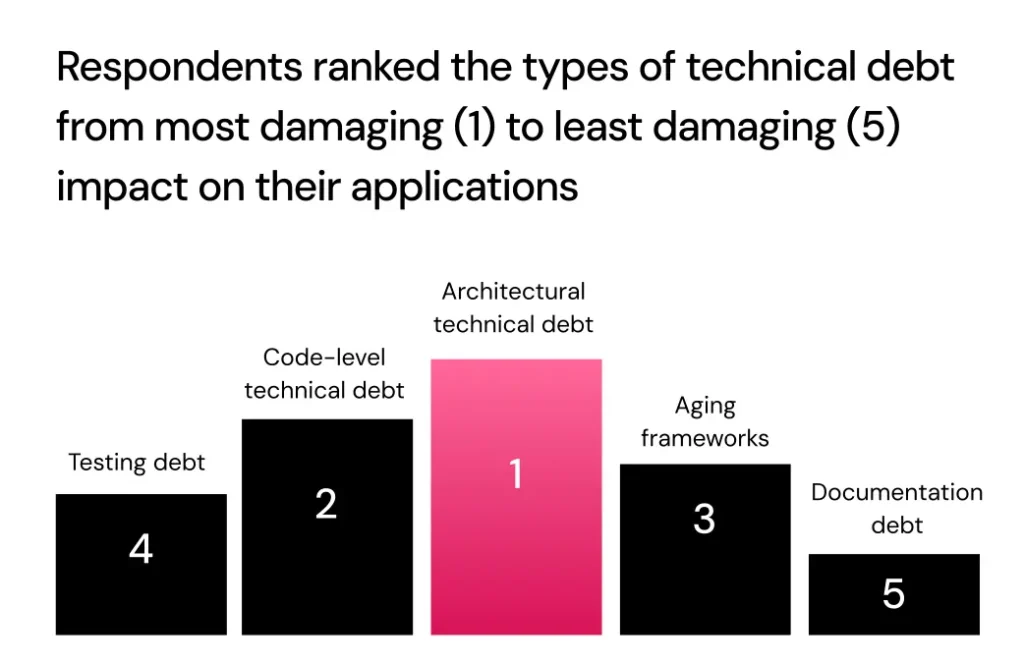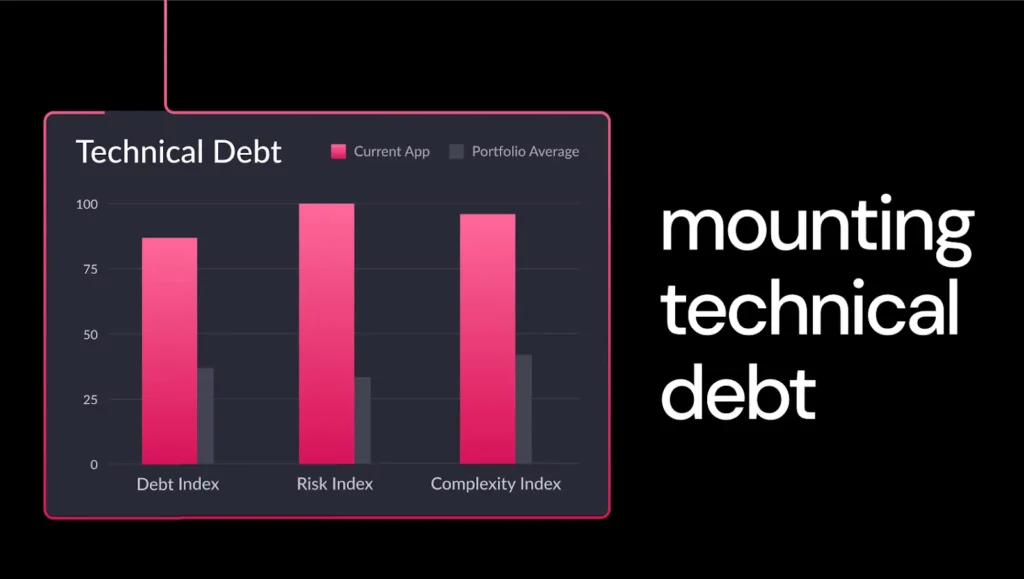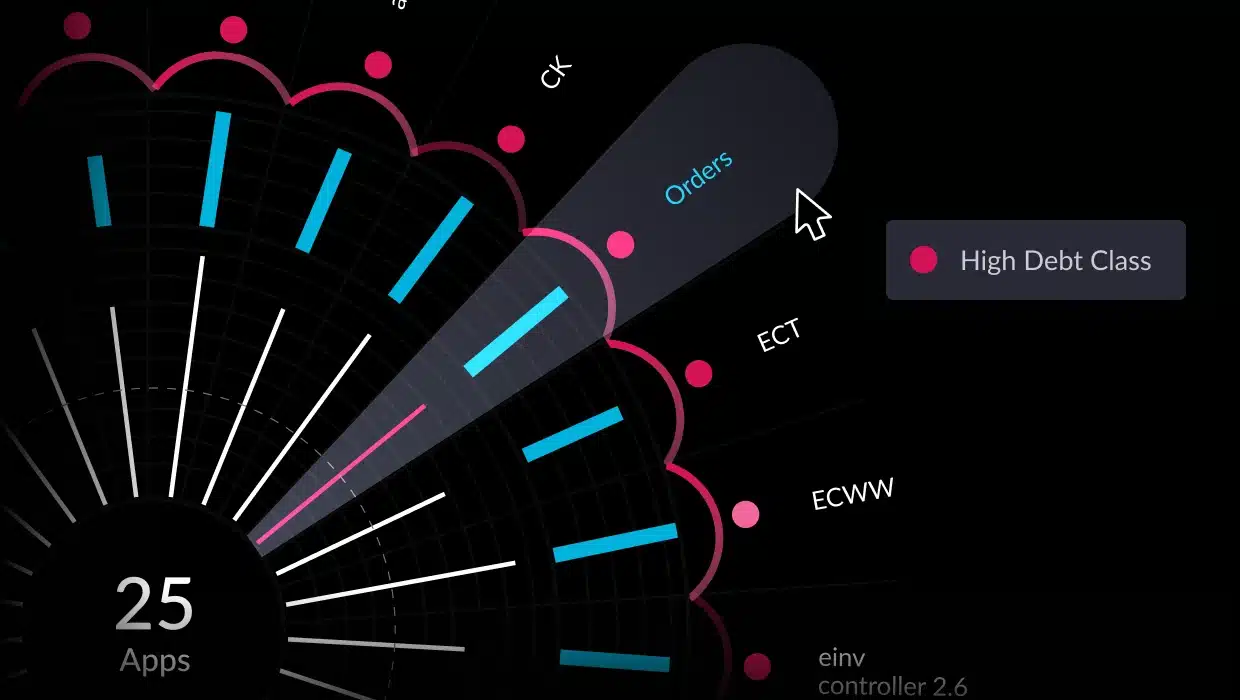When it comes to building software, technical debt is a significant challenge that can impede progress, limit innovation, and potentially derail projects. Like financial debt, technical debt refers to future costs. While sometimes necessary, technical debt can accumulate over time, creating a drag on development and leading to a host of problems down the line.
In this blog, we’ll explain technical debt, explore its various forms, understand its causes and impact, and provide actionable insights to help you manage this inevitable aspect of software development. Whether you’re a developer, engineering manager, or executive, understanding technical debt is crucial to navigating the complexities of modern software projects and ensuring their long-term success.
What is technical debt?
The term “technical debt” was first coined by Ward Cunningham, a renowned software developer and one of the creators of the Agile Manifesto. He drew a parallel between taking shortcuts in software development and incurring monetary debt. Like financial debt, technical debt can provide short-term benefits (speedy delivery, reduced initial cost) but incurs interest in the form of increased complexity, reduced maintainability, and slower future changes.
At its most basic, technical debt can be defined as the cost of rework required to bring a software system to its ideal state. However, a more nuanced definition acknowledges that not all technical debt is equal. Some might be strategic and intentional debt, while others might be accidental or negligent. Is tech debt bad? Martin Fowler’s ‘Technical Debt Quadrant’ categorizes different types of technical debt based on intent and context. Some forms of tech debt, particularly those taken on recklessly or without a repayment plan, should be avoided at all costs.

Alternative terminology and usage
In tech circles, technical debt is sometimes referred to by other names, such as “code debt,” “design debt,” or even “cruft.” These terms generally refer to specific aspects of technical debt but share the core concept of accumulating problems due to past decisions.
Impact on software development and project timelines
Technical debt manifests in various ways, especially in legacy code. It might slow down feature development as developers navigate a tangled codebase. It could lead to more bugs and production issues due to fragile or poorly understood code. In extreme cases, technical debt can render a system unmaintainable, forcing a complete rewrite or system replacement. These impacts inevitably affect project timelines and can significantly increase costs in the long run.
Perspectives from industry experts and academics
Industry experts and academics have extensively studied and debated the concept of technical debt. Some, like Martin Fowler, emphasize distinguishing between intentional and unintentional debt. Others highlight the role of communication and transparency in managing technical debt. Regardless of their perspective, all agree that technical debt is unavoidable in software development and must be carefully managed.
Types of technical debt
Technical debt comes in different forms, each with unique characteristics and implications. Recognizing these types is crucial to effectively managing and addressing technical debt in your projects.
- Architecture debt, often named as the most damaging type of tech debt, refers to compromises or suboptimal decisions made at a system’s architectural level. It might involve using outdated technologies, creating overly complex structures, or neglecting scalability concerns. Architectural debt can be particularly costly as it often requires significant refactoring or a complete system redesign.

- Code debt: This is perhaps the most common type of technical debt and encompasses many issues within the code. It might involve poorly written or convoluted code, lack of proper documentation, or insufficient testing. This can lead to increased maintenance efforts, a higher likelihood of bugs, and difficulty adding new features.
- Design debt: This relates to shortcomings or inconsistencies in the design of the software. It might involve poor user interface design, inadequate error handling, or lack of modularity. Design debt can impact user experience, system reliability, and the ability to adapt to changing requirements.
- Documentation debt: This refers to the lack of or outdated documentation for a software system. It can make it difficult for new developers to understand the codebase, increase onboarding time, and hinder maintenance efforts.
- Infrastructure debt: This type of debt relates to the underlying infrastructure on which the software runs. It might involve outdated hardware, misconfigured servers, or neglected security updates. Infrastructure debt can lead to performance issues, security vulnerabilities, and downtime.
- Test debt: This occurs when insufficient testing or outdated test suites are in place. It can lead to undetected bugs, regressions, and a lack of confidence in deploying new code.
Understanding the different types of technical debt helps identify and prioritize improvement areas. It also allows for more informed decision-making when weighing the short-term benefits of shortcuts against the long-term costs of accumulating debt.
Technical debt examples
Technical debt can manifest in numerous ways, often with far-reaching consequences. Let’s look at a few real-world examples:
The outdated framework
A company builds an application using a popular framework, such as .NET or the latest JDK (Java Development Kit). A few years later, the framework becomes outdated, and security vulnerabilities are discovered. However, updating the framework would require extensive code changes, leading to significant delays and costs. The company decides to postpone the update, accumulating technical debt in the form of a security risk.
The rushed release
Under pressure to meet a tight deadline, a software development team cut corners on testing and documentation. The product was released on time, but users quickly discovered bugs and usability issues. Fixing these problems becomes a constant drain on resources, hindering the development of new features.
The legacy system
A company inherits an extensive legacy system written in an outdated programming language. The system is critical to business operations but challenging to maintain and modify. Every change is risky and time-consuming. The company faces a dilemma: continue struggling with the legacy system or invest in a costly rewrite.
Short-term vs. long-term impacts
The examples above illustrate the trade-offs inherent in technical debt. In the short term, taking shortcuts or making compromises can lead to faster delivery or reduced costs. However, the long-term impacts can be severe.
As more debt piles up, it becomes a drag on your development efforts. Maintenance costs skyrocket, agility plummets, and the overall quality of your software suffers. Bugs become more frequent, performance issues crop up, and security vulnerabilities emerge. And let’s not forget the impact on your team. Developers can become frustrated and demotivated when constantly wrestling with a complex and fragile codebase.
Cost of technical debt
While technical debt might seem like a harmless trade-off in the short term, it can have a significant financial impact in the long run if there is no debt reduction strategy. Let’s break down some of the ways it affects your bottom line:
- Development slowdown: As technical debt builds up, developers spend more and more time navigating complex code, fixing bugs, and working around limitations. This translates into longer development cycles, delayed releases, and missed market opportunities.
- Increased maintenance costs: Maintaining and modifying a system burdened with technical debt requires more effort and resources. Refactoring, bug fixes, and workarounds contribute to higher maintenance costs, diverting resources from new development.
- Opportunity cost: The time and resources spent dealing with technical debt could be invested in developing new features, improving user experience, or exploring new markets. Technical debt can stifle innovation and limit your ability to compete.
Technical bankruptcy: In extreme cases, technical debt can accumulate to the point where a system becomes unmaintainable. This can lead to a complete system rewrite, a costly and time-consuming endeavor that can disrupt business operations.

It’s essential to recognize that technical debt isn’t just a technical problem—it’s a business problem. The costs of technical debt can directly impact your company’s profitability and competitiveness, making managing technical debt a critical priority for many organizations.
What is technical debt in software development?
Technical debt isn’t simply an unavoidable consequence of software development. It often arises from specific causes and contributing factors that, if understood, can be mitigated or even prevented.
Common causes and contributing factors
Let’s break down some of the most frequent offenders:
- Pressure to deliver quickly: The demand for faster time-to-market can lead to shortcuts and compromises in the development process. Rushing to meet deadlines often results in code that’s less than ideal, tests that are skipped, and documentation that’s incomplete or non-existent.
- Lack of precise requirements or shifting priorities: Ambiguous or constantly changing requirements can lead to rework and a system that struggles to adapt to evolving business needs.
- Inadequate testing: Insufficient testing can allow bugs and vulnerabilities to slip through the cracks.
- Lack of technical expertise or experience: Inexperienced developers might inadvertently introduce technical debt due to a lack of understanding of best practices or design patterns.
- Outdated technologies or frameworks: Relying on obsolete technologies or frameworks can lead to maintenance challenges, compatibility issues, and security vulnerabilities. Legacy codebases are usually impacted by this type of debt.
- Poor communication and collaboration: When software development teams don’t communicate effectively or collaborate efficiently, it can lead to misunderstandings, duplicated efforts, and inconsistent code.
Recognizing these causes empowers proactive debt management. Identifying risks early lets you take steps to minimize their impact and keep projects healthy.
How technical debt occurs during the software development lifecycle
Technical debt can creep into your project at any stage of the software development lifecycle. Let’s look at some common scenarios:
- Requirements gathering: Ambiguous or incomplete requirements can lead to rework and code that doesn’t fully meet user needs, contributing to design and code debt.
- Design phase: Rushing through the design phase or neglecting to consider scalability and maintainability can lead to architectural debt that becomes increasingly difficult to address later.
- Development: Tight deadlines, lack of code reviews, and inadequate testing can result in tech debt in messy, buggy, and poorly documented code.
- Testing: Insufficient testing or relying on manual testing can allow bugs to slip through.
- Deployment: Rushing to deploy without proper planning and automation can lead to infrastructure debt, misconfigured servers, and potential downtime.
- Maintenance: Neglecting to refactor and update code regularly can accumulate tech debt over time, making the system increasingly difficult and expensive to maintain.
It is crucial to recognize these potential pitfalls at each stage of the development lifecycle. Proactive measures like thorough requirements gathering, robust design practices, comprehensive automated testing, and regular refactoring help prevent technical debt from becoming unmanageable.
How vFunction can help
Managing and addressing technical debt can be daunting, but it’s essential for maintaining the long-term health and sustainability of your software systems. That’s where vFunction comes in.

vFunction’s platform is designed to help you tackle technical debt challenges in complex, monolithic applications and in modern, distributed applications. Our AI-powered solution analyzes your codebase and identifies areas of technical debt. This allows teams to communicate technical debt issues effectively and provide actionable insights to guide modernization efforts.
Here are some key ways vFunction can help you:
- Assess technical debt: vFunction comprehensively assesses your technical debt, highlighting areas of high risk and complexity.
- Prioritize refactoring efforts: vFunction helps you identify the most critical areas to refactor first, ensuring that your modernization efforts have the greatest impact.
- Automate refactoring: vFunction automates many of the tedious and error-prone tasks involved in refactoring, saving you time and resources.
- Reduce risk: vFunction’s approach minimizes the risk of introducing new bugs or regressions while modernizing legacy systems.
- Accelerate modernization: vFunction enables you to modernize your legacy applications faster and more efficiently, unlocking the benefits of cloud-native architectures.
With vFunction, you can proactively manage technical debt, improve software quality, and accelerate innovation.
Conclusion
Technical debt is inevitable in software development, but it doesn’t have to be a burden. By understanding its causes and proactively managing its impact, you can ensure that technical debt doesn’t derail your projects or hinder your innovation.
Remember, technical debt is not just a technical issue; it’s a business issue. The costs associated with accumulated technical debt can significantly impact your company’s bottom line. Investing in strategies and tools to manage technical debt is an investment in your company’s future.
Solutions like vFunction can provide invaluable support in managing your tech debt load. By leveraging AI and automation, vFunction can help you assess, prioritize, and tackle technical debt efficiently, allowing you to focus on delivering value to your customers and achieving your business goals.







